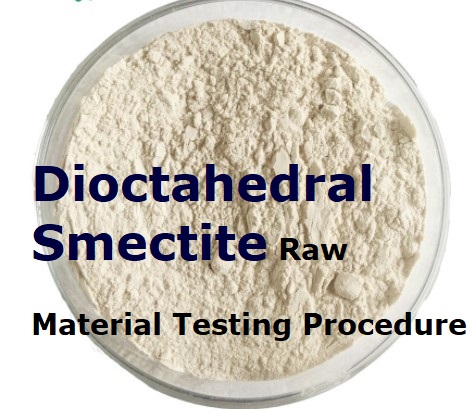
Dioctahedral Smectite Raw Material Testing Procedure or Standard Analytical Procedure of Dioctahedral Smectite
Appearance:
It should be off- white powder.
pH :
Take 1.0g sample; add 50ml water to make a suspension. Shake 5 minutes and stand for 1 hour. Take upper clear water to check pH.
Loss on drying :
Take 2.0 g sample to be examined, dry at 105℃ to constant weight, the result should not exceed 10.0 %( according to CP2005 Volume II appendix VIII L).
Carbonate:
Take 0.2g sample to a test tube; add 2ml water to make a suspension. Add 2ml acetic acid solution (2mol/l) and quickly block it with a plug, which have a bent glass tube in the center. Heat the suspension slowly; collect the escaping gas to calcium hydroxide solution, no white precipitate generated.
Chloride:
Take 0.20g sample, add 25ml water and 1 drop of nitric acid boil for 5 minutes, filter, check the filtrate it should not more than 0.025% chloride. Compare with reference solution made by 5.0ml standard sodium chloride solution, the result shall not be thicker.(0.025%)
Heavy Metals:
Dissolve 1.0 g sample to be examine in 4ml acetic salt buffer solution (pH3.5) add 46 ml water and heat to boil, cool down and filter, add 50ml water to the filtrate and shake. Take 25ml to Nessler cylinders, check heavy metals.. It should less than 10ppm.
Dilatability Take 1.0g sample (on dry basis), use a water solution (containing 0.1% sodium carbonate and 1% sodium sulfate) as solution to check Dilatability in a 50ml measuring cylinder.
Shake the test tube every 10 minutes in the first 1 hour. Then stand for 4 hours, read the volume that the substance have swelled (ml),stand for another 1 hour and read as above, until the difference of two readings less than 0.1ml.Every sample shall be tested in triplicate, take the last read value respectively and calculate as following, the Dilatability of sample is the average value.
V
S=───
W
S: Dilatability
V: the volume of substance after swell (ml)
W: weight of sample on dry basis (g)
Strychnine Absorption:
Transfer 0.20g sample into a conical flask with plug, accurately add 10ml phosphate buffer(pH6.8).Shake for 1 hour and stand for 24 hours. Accurately add 10ml Strychnine sulfate solution (transfer Strychnine sulfate 2.00g into a 100ml measuring flask, add sufficient water, heat in water bath to dissolve, cool down to room temperature. Add water to 100ml and shake thoroughly.) and shake in 37℃ water bath for 1 hour; filter and measure 10ml filtrate accurately and transfer to a 250 ml measuring flask, add phosphate buffer(pH6.8)and dilute to 250ml,shake thoroughly. Measuring 5ml accurately and transfer to 50ml measuring flask, add above phosphate buffer (pH6.8)to 50ml,shake thoroughly and check absorbance at 254nm A. Meantime take sufficient Strychnine sulfate solution and add phosphate buffer(pH6.8)to make a solution of 20ug/ml, use the same method to check the absorbance. The result can be calculated as follows:
Absorbance Of Sample
Strychnine absorption = ——————————-
Absorbance Of Blank.
Al2O3,%
Weight 1.0g sample accurately and transfer to porcelain dish, add 6ml sulphuric acid and 10ml nitric acid, wait until react completely. Put the porcelain dish on bath sand and evaporate to dryness; stand and cool down, add 30ml dilute sulphuric acid and boil, decantation filter the upper solution with ashless filter paper; the residue is washed by hot water for 3 times and filter the washing water along with residue; transfer the residue to filter paper, wash it with hot water, ready for use of SiO2 testing; mix the filtrate and transfer to 100ml measuring flask, cool to room temperature, add water to 100ml,shake thoroughly; measuring 20ml accurately and add ammonia solution to neutralize. Stop add ammonia solution as soon as precipitation is generated. Titrate dilute sulphuric acid accurately until the precipitation dissolved completely. Add 10ml acetic acid-ammonium acetate buffer (pH 6.0) and 25ml Disodium Edetate volumetric solution(0.05mol/l) accurately, boil for 3~5 minutes, cool to room temperature. Add 1ml Xylenol orange indicator solution and titrate with zinc volumetric solution(0.05mol/l until the color of solution become red from yellow. Meantime calibrate the titration result by blank solution. 1ml Disodium Edetate volumetric solution (0.05mol/l) equals 2.549mg Al2O3.
SiO2,%
Transfer above residue along with filter paper to crucible, dry, burning at 800℃ for 2 hours; cool and weight accurately. Moist residue with water, add 7ml fluohydric acid and 7 drops of sulphuric acid, evaporate to dryness and burning at 800℃ for 5 minutes. Weight accurately. The lost weight is the weight of SiO2 in the sample.

